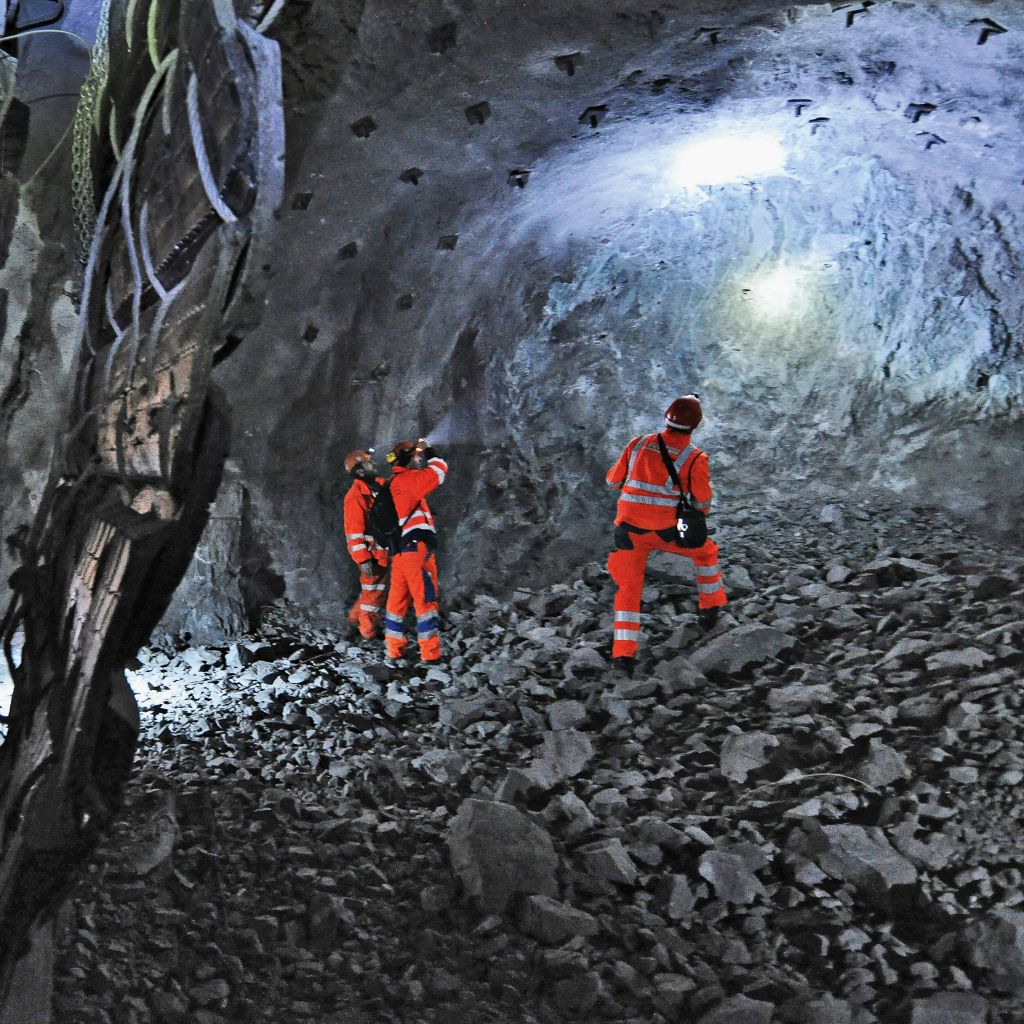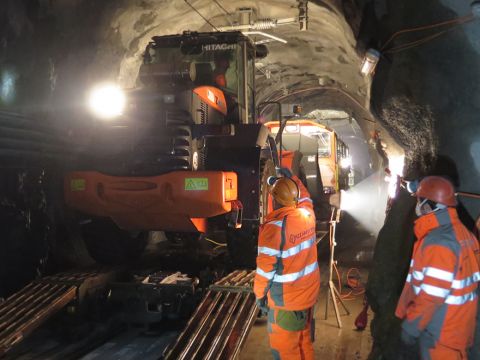Tunneling at the Albula Tunnel

Tunnelling is to take place from the Preda and Spinas ends simultaneously. This chronologically parallel excavation promises to ensure fast completion and the necessary degree of flexibility, if an incident should occur at one or both ends. It also ensures fast arrival at the point where high-quality rock containing Albula granite can be extracted for further use.
Various factors are assessed when determining the best-possible approach. Access to the site and the continuance of railway operations need to be taken into account, for example, along with costs and timetabling.
The approach is based on existing geological conditions and economic factors. There are also environmental factors to be taken into account when considering blasting work in the Albula Tunnel. Blasting produces up to 21% less excavated material than a tunnel boring machine. The advantage of blasting is therefore that there is less material to handle and a considerably reduced amount of landfill to dispose of. In the case of blasting, the cross-section of the rocks being traversed can be adapted flexibly in the short term.
Tunnelers kitted out with explosives are tackling the hard rock of the Albula massif. Blasting for purposes of excavation is carried out in stages, at intervals of about 3 to 4 metres.
The blasting process is carried out as follows:
|
1. |
A so-called “Jumbo” drilling machine is used to make holes in the rock face inside the tunnel |
||
|
2. |
The drill holes are cleaned out with compressed air and inspected |
||
|
3. |
The holes are then loaded with explosives and detonators |
||
|
4. |
The system of detonation is attached: A detonation circuit is installed, with lines running to the plunger |
||
|
5. |
The drill holes are blocked up, and checked once more |
||
|
6. |
The area is evacuated, and all those present shelter in a metal container provided for protection |
||
|
7. |
The charges explode |
||
|
8. |
Those present wait in the protective container until the dust has settled and/or the fumes and gases have dispersed, and there is sufficient fresh air |
||
|
9. |
The newly-blasted rock face is checked for loose pieces of rock, and cleaned accordingly |
||
|
10. |
The working area is secured with anchoring elements and protective mesh, before shotcrete is applied |
||
|
11. |
Rubble: Excavation and outward transfer of resulting rubble |
Blasting is to take place along almost the entire length of the 5,860-metre Albula Tunnel, with the sole exception is of the sections of loose rock (of approximately 257 metres in length) and the zone containing Raibler cellular limestone (approx. 130 m), where excavation work will be carried out with a mechanical pick.
In the areas of loose rock and the Raibler cellular limestone special blasting procedures are necessary to penetrate the tunnel.
Preliminary excavation
Before tunnelling work can begin, a vertical pit wall covering the entire tunnel profile must be installed as a starting point. This pit wall constitutes the “preliminary excavation” (in the ground) for subsequent tunnelling work. Initial excavation of the tunnel is to be in the form of an open pit, rather than a mining operation.
Preda
The initial excavation work is to be secured with respect to the existing tunnel by means of an open, back-anchored retaining wall. The excavation from the opposite end is to be secured by means of the same system along the last few metres leading to the entrance wall. The remaining embankments are to be secured by means of soil nail walls. The new portal will be set slightly back with respect to the entrance of the existing Albula Tunnel, and clad with natural stone.
Spinas
The northern embankment at the side of the new tunnel is to be secured by means of a soil nail wall. The new portal will be built as an extension of the existing entrance, and likewise clad with natural stone.
Loose rock
Excavation work involving sections of loose surface rock at the Preda (27 m) and Spinas (230 m) ends is carried out from the shelter of a protective pipe umbrella. Sections of pipe measuring up to 15 metres in length are inserted into the part of the area being tunnelled, placed lengthways to the tunnel and outside the cross-section being excavated. The first stage is to drill holes. In the second stage, the pipes are inserted into the holes and secured on the inside and outside with injected cement. This screen protects the existing mountain, and allows the tunnel to be excavated and secured in short stages. A new pipe umbrella is to be installed every ten metres, which allows the pipes to overlap. .
Raibler cellular limestone
The mountain rock is to be treated previously for the purpose of tunnelling through cellular limestone. The surrounding rock is to be secured to reduce its permeability. This is achieved in different ways, depending on the state of the rock. Along the initial section of approximately 100 metres in length, the rock is to be secured by both injection and sealing. There is so-called “floating” rock along the final 25 metres, which is to be stabilised by freezing, and then sealed. Freezing is to be carried out from a previously created hollow located just after the Raibler cellular limestone, from where longitudinal holes are drilled around the area that is to be broken out. The freezing tubes are then inserted into these drill holes to provide a connection with the refrigerating equipment installed in the hollow. The water already present in the rock is then frozen to secure and seal all the surrounding rock. An accurately dimensioned, almost circular tunnel can then be excavated in the frozen area. Excavation and securing take place in short stages of one metre in length.

